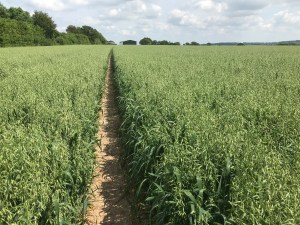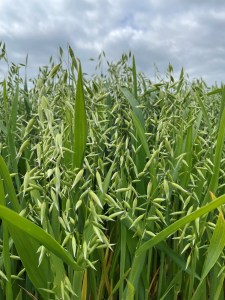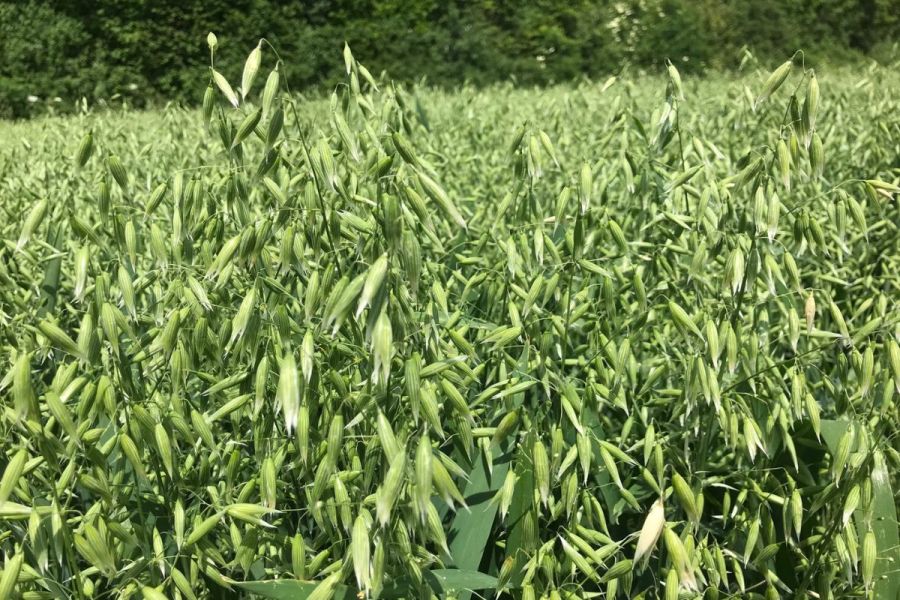One name has dominated the oat market for a prolonged period, with none able to compare, but that might be about to change. Cromwell, Senova’s new oat variety, has appealing yields, good agronomics and the all-important, grain quality. CPM takes a closer look.
“We’ve been able to demonstrate that planting winter oats earlier than traditionally gets better results.”
By Melanie Jenkins

According to Tom Yewbrey, the human consumption market for oats has been growing steadily for a number of years.
Whether it’s Thomas or Oliver Cromwell being considered, there’s little doubt of either’s historical significance. And by the looks of things, Senova’s Cromwell could be making history of its own in the oat market.
Senova’s Tom Yewbrey explains what makes Cromwell promising. “A number of varieties have been brought forward that have demonstrated improved yields but not the grain quality required by millers, and this is why Cromwell is so important for the market.”
For nearly two decades, Mascani has been the miller’s favourite, reliably delivering a quality grain. “It’s the first variety in a long time to bring quality similar to Mascani along with a significant yield improvement – 7 percentage points in this case – and it’s this combination which makes it stand out,” says Tom.
Cromwell is a Mascani cross, which has united grain quality and improved yields with good agronomic features. “It has the highest specific weight of any husked variety on AHDB’s Recommended List at 55.3kg/hl, with a high kernel content – just below Mascani in our testing – and it has shown good hullability, which is an important trait for millers.”
But individual millers have different requirements, admits Tom. “So in terms of varieties, many now specify which they’re willing to buy. However, they’ll be looking at those three characteristics – kernel content, hullability and quality.”
Richardson Millers UK test new varieties for breeders at a reasonably early stage, explains the firm’s Brin Hughes. “We tend to wait until a variety gets on to National List 2 and then run our own trials. Sometimes, prior to this we get samples from breeders, including the Institute of Biological, Environmental and Rural Sciences (IBERS), which are tested in our lab for quality parameters, like specific weight, screenings and hulling losses, as these are the most important factors for us – we are less focused on how a variety yields.
“We’ve identified Cromwell as looking promising and last year put it into our own small plot replicated trials alongside Mascani and a few other varieties. It’s important for us to have an alternative variety to Mascani because, although we prefer it and wish everyone grew it due to its consistent quality, we’re keen to have other variety options in the market so that not all our eggs are in a single basket.”
In Richardson’s trials last year, Cromwell yielded slightly better than Mascani, notes Brin. “But more importantly, its specific weight was slightly better. We were somewhat concerned about the level of screenings as these were on the high side, so this is something to keep an eye on. It’s not a major issue but it isn’t ideal as it means the milling quality is reduced and farmers also lose some value.”

In terms of disease resistance, Cromwell scores a 5 against crown rust meaning it’s similar to most varieties on AHDB’s Recommended List.
Tom feels that the higher than expected screenings last year were due to the season. “Last year’s dry weather pushed up screenings at a number of sites, putting Cromwell closer to Gerald and Dalguise.”
One of the most important factors for Richardson is the losses at hulling. “At the milling stage, a major focus for us is the proportion we lose when we de-hull the oats. Mascani is very good in this respect and we tend to only lose 26-30% on average. This sounds high but Mascani is one of the best and it’s why we prefer it,” explains Brin.
Cromwell has shown very good levels of hullability, on a par with Mascani, says Tom. “While there can be variability year-to-year, it’s done well in this regard, and it has a kernel content of 74.9%.”
Although millers have seen small samples, it’s the big commercial loads which will really prove whether Cromwell will make the grade, explains Brin. “If Cromwell meets specification from these loads, then we’d be happy with it. But if a variety doesn’t meet specification, then from our perspective, it’s only good for feed.”
Looking at Cromwell’s agronomics, the variety has a rating of 8 for standing ability, although this is only based on limited data, says Tom. “This is the highest of the husked varieties on the RL, which is an important feature to have with oats.”
The new variety is slightly later maturing than Mascani at +1, and it’s around 1m tall compared with the usual 1.2m-1.25m, explains Sandy Cowan, Cromwell’s breeder at IBERS. “It has shorter straw which is easier to manage and could potentially be grown without a PGR.”
In terms of disease resistance, it scores a 5 against crown rust meaning it’s similar to most varieties on the list, he explains. “This is something which we hope to improve with future varieties.”
Sandy explains that a potential downside with Cromwell is that its mildew rating – at 3 on the RL – isn’t as strong as the other recommended varieties. “However, agronomists say this can be treated relatively easily in most cases. Quite often in breeding, when we achieve good grain quality it’s at the expense of yield or disease resistance – there’s always been a compromise.”

According to Brin Hughes, specific weight, screenings and hulling losses are the most important oat characteristics for Richardson Millers.
Further to straight trials on quality and yields, Richardson have also looked at drilling date, seed rates, nitrogen and other inputs, with a view to helping growers get the best quality from the oats, explains Brin. “This is a key focus for us and we’ve been able to demonstrate that planting winter oats earlier than traditionally gets better results.
“Oats tend to get left and planted at the end of October, or even later, often with too high a seed rate, which compromises crop growth and yields. Our trials show that planting them earlier and at a slightly lower seed rate than growers may be used to delivers better yields and quality. This is because late sown crops with too high a seed rate grow too tall. An early sown crop with a lower seed rate develops better root structure and stiffer stems which keeps it standing, and it allows slightly more N to be applied.”
Brin feels that there can be a tendency to be too conservative when it comes to N applications with oats. “The fear is that you’ll overdo it and increase lodging, but if you establish a better crop structure by drilling earlier at lower seed rates, then you can put on a more appropriate rate of N, achieve better yields and quality, and still use less than most other winter crops.”
So Cromwell ticks boxes for growers and end users alike, but is there space for it? According to Tom, the human consumption market for oats has been growing steadily for a number of years, with new innovations and products coming through all the time.
“In addition, there’s a lot of investment in oat processing and production, big mills in the UK are expanding and a new mill is near completion. It’s a really positive time for the oat market.”
Brin also agrees that the end market for oats has gradually been increasing. “For the past 20 years, we’ve seen steady growth as consumers become more aware of the health benefits of eating oats. The various oat food brands have successfully marketed those benefits, and the recent development of the oat milk market has continued that growth, which in turn is great for farmers.”

Cromwell has a rating of 8 for standing ability, although this is only based on limited data, and it’s the highest of the husked varieties on the RL.
And as the depth of understanding into the health benefits of oats increases, this could further grow the market, according to Sandy. “We’re working on a few projects with Swansea University looking at how eating oats can help control diabetes. The beta glucan in them can also help reduce coronary heart disease, plus oats are gluten free and include antioxidants which stabilises their oil content, meaning the fatty acids in them are good for people’s health.”
But where next? Tom acknowledges that there’s been quite a gap between the release of Mascani and Cromwell, explaining that it’s hard for breeders to achieve improvements in yield and quality at the same time. “We’re very focused on producing high quality oats for milling, but we’re also targeting disease resistance and improving that, all while maintaining the standing ability. We just hope the wait for the next variety of this type to isn’t so long.”
However, it takes 12 or more years from an initial cross to get a new winter oat variety, says Sandy. “We’re now doing marker assisted work to improve precision in the breeding programme. This means we can screen leaf material instead of the grain, which allows us to be more efficient. We’re also exploring the use of drone image analysis techniques to analyse field trial data.”
One aspect of Sandy’s research involves trying to make oats more commercially economic. “We’re looking at how oats respond to precise inputs and mapping genetic populations in relation to this, be it better rooting or more efficient use of water. In the long term, we should be able to produce more resilient crops with better genetic disease and pest resistance.
“Breeding is a numbers game, and when you change one aspect of an oat it has an effect on another,” he says. “So getting the right combination of genetics that mean a variety will grow well and perform consistently is hard. This is something Mascani does and hopefully Cromwell will demonstrate this same habit.”
This article was taken from the latest issue of CPM. Read the article in full here.
For more articles like this, subscribe here.
Sign up for Crop Production Magazine’s FREE e-newsletter here.




